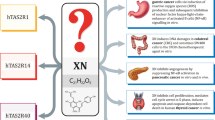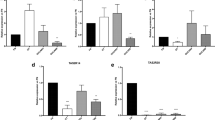Abstract
The 25 bitter taste receptors (T2Rs) in humans perform a chemosensory function. However, very little is known about the level of expression of these receptors in different tissues. In this study, using nCounter gene expression we analyzed the expression patterns of human TAS2R transcripts in cystic fibrosis bronchial epithelial (CuFi-1), normal bronchial epithelial (NuLi-1), airway smooth muscle (ASM), pulmonary artery smooth muscle (PASM), mammary epithelial, and breast cancer cells. Our results suggest a specific pattern of TAS2R expression with TAS2R3, 4, 5, 10, 13, 19, and 50 transcripts expressed at moderate levels and TAS2R14 and TAS2R20 (or TASR49) at high levels in the various tissues analyzed. This pattern of expression is mostly independent of tissue origin and the pathological state, except in cancer cells. To elucidate the expression at the protein level, we pursued flow cytometry analysis of select T2Rs from CuFi-1 and NuLi-1 cells. The expression levels observed at the gene level by nCounter analysis correlate with the protein levels for the T2Rs analyzed. Next, to assess the functionality of the expressed T2Rs in these cells, we pursued functional assays measuring intracellular calcium mobilization after stimulation with the bitter compound quinine. Using PLC inhibitor, U-73122, we show that the calcium mobilized in these cells predominantly takes place through the Quinine–T2R–Gαβγ–PLC pathway. This report will accelerate studies aimed at analyzing the pathophysiological function of T2Rs in different extraoral tissues.





Similar content being viewed by others
References
Sharman JL, Benson HE, Pawson AJ, Lukito V, Mpamhanga CP, Bombail V, Davenport AP, Peters JA, Spedding M, Harmar AJ, Nc I (2013) IUPHAR-DB: updated database content and new features. Nucleic Acids Res 41(Database issue):D1083–D1088. doi:10.1093/nar/gks960
Adler E, Hoon MA, Mueller KL, Chandrashekar J, Ryba NJP, Zuker CS (2000) A novel family of mammalian taste receptors. Cell 100(6):693–702. doi:10.1016/S0092-8674(00)80705-9
Chandrashekar J, Mueller KL, Hoon MA, Adler E, Feng LX, Guo W, Zuker CS, Ryba NJP (2000) T2Rs function as bitter taste receptors. Cell 100(6):703–711. doi:10.1016/S0092-8674(00)80706-0
Wu SV, Rozengurt N, Yang M, Young SH, Sinnett-Smith J, Rozengurt E (2002) Expression of bitter taste receptors of the T2R family in the gastrointestinal tract and enteroendocrine STC-1 cells. Proc Natl Acad Sci USA 99(4):2392–2397. doi:10.1073/pnas.042617699
Shaik FA, Singh N, Arakawa M, Duan K, Bhullar RP, Chelikani P (2016) Bitter taste receptors: extraoral roles in pathophysiology. Int J Biochem Cell Biol. doi:10.1016/j.biocel.2016.03.011
Hofer D, Puschel B, Drenckhahn D (1996) Taste receptor-like cells in the rat gut identified by expression of alpha-gustducin. Proc Natl Acad Sci USA 93(13):6631–6634
Tizzano M, Gulbransen BD, Vandenbeuch A, Clapp TR, Herman JP, Sibhatu HM, Churchill MEA, Silver WL, Kinnamon SC, Finger TE (2010) Nasal chemosensory cells use bitter taste signaling to detect irritants and bacterial signals. Proc Natl Acad Sci USA 107(7):3210–3215. doi:10.1073/pnas.0911934107
Shah AS, Ben-Shahar Y, Moninger TO, Kline JN, Welsh MJ (2009) Motile cilia of human airway epithelia are chemosensory. Science 325(5944):1131–1134. doi:10.1126/science.1173869
Deshpande DA, Wang WC, McIlmoyle EL, Robinett KS, Schillinger RM, An SS, Sham JS, Liggett SB (2010) Bitter taste receptors on airway smooth muscle bronchodilate by localized calcium signaling and reverse obstruction. Nat Med 16(11):1299–1304. doi:10.1038/nm.2237
Upadhyaya JD, Singh N, Sikarwar AS, Chakraborty R, Pydi SP, Bhullar RP, Dakshinamurti S, Chelikani P (2014) Dextromethorphan mediated bitter taste receptor activation in the pulmonary circuit causes vasoconstriction. PLoS ONE 9(10):e110373. doi:10.1371/journal.pone.0110373
Foster SR, Porrello ER, Purdue B, Chan HW, Voigt A, Frenzel S, Hannan RD, Moritz KM, Simmons DG, Molenaar P, Roura E, Boehm U, Meyerhof W, Thomas WG (2013) Expression, regulation and putative nutrient-sensing function of taste GPCRs in the heart. PLoS ONE 8(5):e64579. doi:10.1371/journal.pone.0064579
Li F, Zhou ML (2012) Depletion of bitter taste transduction leads to massive spermatid loss in transgenic mice. Mol Hum Reprod 18(6):289–297. doi:10.1093/molehr/gas005
Clark AA, Dotson CD, Elson AE, Voigt A, Boehm U, Meyerhof W, Steinle NI, Munger SD (2015) TAS2R bitter taste receptors regulate thyroid function. FASEB J 29(1):164–172. doi:10.1096/fj.14-262246
Maurer S, Wabnitz GH, Kahle NA, Stegmaier S, Prior B, Giese T, Gaida MM, Samstag Y, Hansch GM (2015) Tasting Pseudomonas aeruginosa biofilms: human neutrophils express the bitter receptor T2R38 as sensor for the quorum sensing molecule N-(3-oxododecanoyl)-l-homoserine lactone. Front Immunol 6:369. doi:10.3389/fimmu.2015.00369
Wolfle U, Elsholz FA, Kersten A, Haarhaus B, Muller WE, Schempp CM (2015) Expression and functional activity of the bitter taste receptors TAS2R1 and TAS2R38 in human keratinocytes. Skin Pharmacol Physiol 28(3):137–146. doi:10.1159/000367631
Singh N, Vrontakis M, Parkinson F, Chelikani P (2011) Functional bitter taste receptors are expressed in brain cells. Biochem Biophys Res Commun 406(1):146–151. doi:10.1016/j.bbrc.2011.02.016
Singh N, Chakraborty R, Bhullar RP, Chelikani P (2014) Differential expression of bitter taste receptors in non-cancerous breast epithelial and breast cancer cells. Biochem Biophys Res Commun 446(2):499–503. doi:10.1016/j.bbrc.2014.02.140
Lund TC, Kobs AJ, Kramer A, Nyquist M, Kuroki MT, Osborn J, Lidke DS, Low-Nam ST, Blazar BR, Tolar J (2013) Bone marrow stromal and vascular smooth muscle cells have chemosensory capacity via bitter taste receptor expression. PLoS ONE 8(3):e58945. doi:10.1371/journal.pone.0058945
Foster SR, Roura E, Thomas WG (2014) Extrasensory perception: odorant and taste receptors beyond the nose and mouth. Pharmacol Ther 142(1):41–61. doi:10.1016/j.pharmthera.2013.11.004
Kulkarni M (2011) Digital multiplexed gene expression analysis using the NanoString nCounter system. Curr Protoc Mol Biol/edited by Frederick M Ausubel[et al]:Unit25B. 10
Geiss GK, Bumgarner RE, Birditt B, Dahl T, Dowidar N, Dunaway DL, Fell HP, Ferree S, George RD, Grogan T, James JJ, Maysuria M, Mitton JD, Oliveri P, Osborn JL, Peng T, Ratcliffe AL, Webster PJ, Davidson EH, Hood L, Dimitrov K (2008) Direct multiplexed measurement of gene expression with color-coded probe pairs. Nat Biotechnol 26(3):317–325. doi:10.1038/nbt1385
Liggett SB (2013) Bitter taste receptors on airway smooth muscle as targets for novel bronchodilators. Expert Opin Ther Targets 17(6):721–731. doi:10.1517/14728222.2013.782395
Foster SR, Porrello ER, Stefani M, Smith NJ, Molenaar P, Dos Remedios CG, Thomas WG, Ramialison M (2015) Cardiac gene expression data and in silico analysis provide novel insights into human and mouse taste receptor gene regulation. Naunyn-Schmiedeberg’s Arch Pharmacol 388(10):1009–1027. doi:10.1007/s00210-015-1118-1
Robinett KS, Koziol-White CJ, Akoluk A, An SS, Panettieri RA Jr, Liggett SB (2014) Bitter taste receptor function in asthmatic and nonasthmatic human airway smooth muscle cells. Am J Respir Cell Mol Biol 50(4):678–683. doi:10.1165/rcmb.2013-0439RC
Bravi F, Bosetti C, Tavani A, Gallus S, LaVecchia C (2013) Coffee reduces risk for hepatocellular carcinoma: an updated meta-analysis. Clin Gastroenterol Hepatol 11(11):1413. doi:10.1016/j.cgh.2013.04.039
Gao F, Li M, Liu WB, Zhou ZS, Zhang R, Li JL, Zhou KC (2015) Epigallocatechin gallate inhibits human tongue carcinoma cells via HK2-mediated glycolysis. Oncol Rep 33(3):1533–1539. doi:10.3892/or.2015.3727
Lamy V, Roussi S, Chaabi M, Gosse F, Schall N, Lobstein A, Raul F (2007) Chemopreventive effects of lupulone, a hop beta-acid, on human colon cancer-derived metastatic SW620 cells and in a rat model of colon carcinogenesis. Carcinogenesis 28(7):1575–1581. doi:10.1093/carcin/bgm080
Park JB, Lee CS, Jang JH, Ghim J, Kim YJ, You S, Hwang D, Suh PG, Ryu SH (2012) Phospholipase signalling networks in cancer. Nat Rev Cancer 12(11):782–792. doi:10.1038/nrc3379
Bertagnolo V, Benedusi M, Brugnoli F, Lanuti P, Marchisio M, Querzoli P, Capitani S (2007) Phospholipase C-beta 2 promotes mitosis and migration of human breast cancer-derived cells. Carcinogenesis 28(8):1638–1645. doi:10.1093/carcin/bgm078
Upadhyaya JD, Chakraborty R, Shaik FA, Jaggupilli A, Bhullar RP, Chelikani P (2016) The pharmacochaperone activity of quinine on bitter taste receptors. PLoS ONE 11(5):e0156347. doi:10.1371/journal.pone.0156347
Zhang CH, Lifshitz LM, Uy KF, Ikebe M, Fogarty KE, ZhuGe R (2013) The cellular and molecular basis of bitter tastant-induced bronchodilation. PLoS Biol 11(3):e1001501. doi:10.1371/journal.pbio.1001501
Pydi SP, Singh N, Upadhyaya J, Bhullar RP, Chelikani P (2014) The third intracellular loop plays a critical role in bitter taste receptor activation. BBA Biomembr 1838(1):231–236. doi:10.1016/j.bbamem.2013.08.009
Pydi SP, Upadhyaya JD, Singh N, Bhullar RP, Chelikani P (2012) Recent advances in structure and function studies of bitter taste receptors. Curr Protein Pept Sci 13(6):501–508
Acknowledgements
This work was supported by a Discovery grant from the Natural Sciences and Engineering Research Council of Canada (RGPIN-2014-04099) and a Manitoba Medical Service Foundation Allen Rouse Career Award to PC, and a catalyst grant from the Biology of Breathing theme, Children’s Hospital Research Institute (CHRIM), to KD and PC. AJ and JDU were supported by graduate studentships from the University of Manitoba and Research Manitoba.
Author information
Authors and Affiliations
Corresponding author
Electronic supplementary material
Below is the link to the electronic supplementary material.
Rights and permissions
About this article
Cite this article
Jaggupilli, A., Singh, N., Upadhyaya, J. et al. Analysis of the expression of human bitter taste receptors in extraoral tissues. Mol Cell Biochem 426, 137–147 (2017). https://doi.org/10.1007/s11010-016-2902-z
Received:
Accepted:
Published:
Issue Date:
DOI: https://doi.org/10.1007/s11010-016-2902-z




